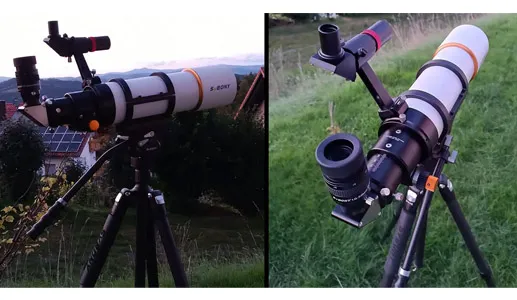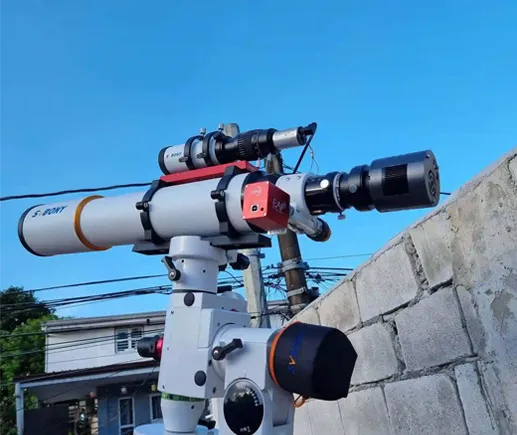Achromatic vs Apochromatic Refractors: Ultimate Comparison

Achromatic vs Apochromatic Refractors: Ultimate Comparison
If you're stepping into the world of astronomy, choosing the suitable telescope can be challenging. With a wide range of sizes, prices, and optical qualities available, it's essential to understand what sets these telescopes apart. In this guide, we’ll break down the key features and considerations that will help you make an informed decision.
When it comes to buying a telescope, one of the first thing you will have to do is whether to go for a refractor or reflector design. Refractor telescopes, such as the classic Dobsonian telescope, use lenses to gather and focus light from distant objects, while reflector telescopes, such as the Maksutov Cassegrain Telescope or Maksutov Newtonian Telescope, use curved mirrors to collect and focus the light.
How Do Refractor Telescopes Work?
Refractor telescopes use glass lenses to focus light and bring celestial images into sharp view. As one of the oldest telescope designs, refractors are favored by both beginners and seasoned astronomers for their simplicity and effectiveness. High-quality refractors offer exceptional contrast and clarity, while entry-level models provide a user-friendly experience at an affordable price. Regardless of your skill level or budget, refracting telescopes are an excellent choice for visual observers and astrophotographers of any skill level.
Here is a comparison table outlining the differences between refractor and reflector telescopes based on various criteria:
| Criteria | Refractors | Reflectors |
|---|---|---|
| Optical Design | Use lenses to bend and focus light. The primary lens (objective) gathers light and brings it to a focal point. | Use mirrors to collect and reflect light. A primary mirror gathers light and reflects it to a focal point, which can then be viewed through an eyepiece. |
| Image Quality | Generally provide high-contrast images with minimal optical aberrations, especially in higher-end models. | Exhibit some optical aberrations, such as spherical aberration or diffraction spikes caused by the support structure of the secondary mirror. |
| Chromatic Aberration | Lower-quality refractors can suffer from chromatic aberration (color fringing). | No chromatic aberration. |
| Focusing Mechanism | Focus light directly through the objectives, creating a more straightforward optical path. | Light reflects off the primary mirror, then may bounce off a secondary mirror before reaching the eyepiece, making the optical path more complex. |
| Field of View | Generally provide a narrow field of view, making them suitable for viewing planets and stars. | Offer a wider field of view, beneficial for deep-sky observation. |
| Size and Portability | Usually longer and can become heavier as the aperture increases. | Have larger apertures while remaining relatively compact. However, larger models can also be bulky and require more effort to transport. |
What is Chromatic Aberration (CA), and Should I Be Concerned?
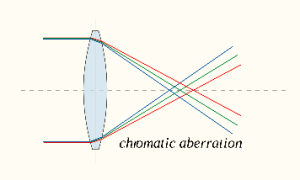
As is the case with all optical systems, they are the sum of their design compromises. With refractors, we have no obstruction in the light path, but we do have to deal with chromatic aberration that results from our bending of light to bring it to a focal point.
The objective lens tends to split the light into colors, like a prism. As the light moves down the tube, the colors don’t arrive at the focal point precisely together, and this distorts the color, causing chromatic aberration, or CA. In addition to causing color distortion, this will reduce the sharpness of the image.
While it’s common in entry-level telescopes, beginners shouldn't worry too much about it. The visual experience remains enjoyable, and more advanced models tend to minimize this issue.
To address CA, two objective lens designs have emerged: the achromatic refractor and the apochromatic refractor.
Achromatic Refractor
Entry-level and lower-cost refractor telescopes are usually of an achromatic design. You may also see these called achromats or achro refractors.
Their objective lens is based on two lens elements made of different types of glass. Because the objective lens is made up of two lenses, they may also be referred to as “doublets.”
The two lens elements are made of different types of glass, each of which bends the light in a slightly different way. A common combination would be one lens made of Crown glass and one of Flint glass.
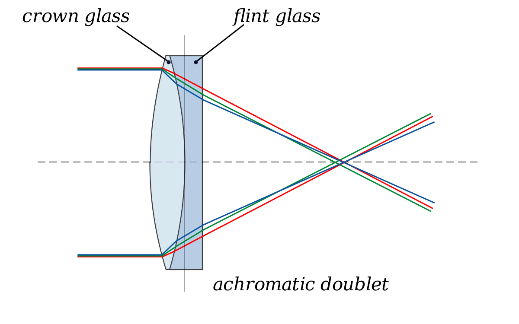
The result is that the colors arrive at the eyepiece more closely merged than with a single lens objective, but the effect is not perfect. Image quality can be very good for most visual observing, but when viewing bright objects, such as the Moon and planets, there can be color fringing that appears in the eyepiece but is not a characteristic of the object being observed.
Many people are very tolerant of CA for visual astronomy because they know what it is, so they ignore it. Others are more sensitive to it and find it quite annoying. And, because the three colors are not precisely aligned, it can degrade the sharpness of the image.
Achromatic refractors come in a variety of aperture sizes and are extremely popular, even among experienced observers, due to their low cost and lightweight. The lightweight also allows them to be put on lighter-weight mounts, which further reduces cost. These are the reasons it tends to be the most prevalent design in the entry-level market.
Apochromtic Refractor
While we may choose to ignore the chromatic aberration, the camera cannot. This results in very pronounced color fringing around objects. Though you can use an achromat for astrophotography and do some cleanup of the image on the computer, if your focus is astrophotography, an achromat is not the best tool for you.
To better address the CA issue, the apochromatic refractor was developed, often referred to as an “APO” for short. The apochromatic design is based on adding a third objective lens element and using more expensive and exotic glass types. It is sometimes referred to as a “triplet.” The apochromatic refractor virtually eliminates chromatic aberration.
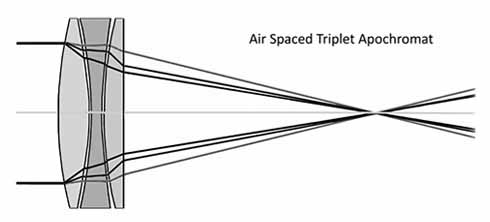
APO refractors are much more expensive than achromatic refractors. The three-lens objective and the special glass used add greatly to the price. They are also significantly heavier than the achromats, which means that the mounts that support them must be stronger, more robust, and more expensive.
ED Achromat – The in-between refractor
Recent improvements in the achromatic refractor design have been made based on the introduction of new forms of ED (extra-low dispersion) glass that further reduce CA over the typical Crown/Flint glass objective lens. These ED refractors, based on a two-element objective, have created a category between the APO and the achromat. You will see them referred to as ED achromats, ED APOs, or ED doublets.
From a pricing standpoint, they fall between the achromat and the APO refractors. For visual use, they are very good, with CA further reduced by 90% or more compared to the same focal ratio achromat. In fact, for visual use, they may present no perceivable CA at all. But they are not quite as free of CA as the APO designs.
For visual use, ED achromats make an excellent upgrade from entry-level achromats. And some entry-level Astro photographers have found them good enough. The Astrophotographer can use computer tools to process the images to eliminate any small remaining CA effects.
Understanding Achromatic, Doublets, Triplets
When exploring refractor telescopes, you'll come across terms like doublet, triplet, and quadruplet (or Petzval). These terms refer to the number of lens elements in the telescope's design, each with its own characteristics:
| Type | Cost | Lens Elements | Visual & Imaging Quality | Chromatic Aberration | Suitable audience | Recommend OTA |
|---|---|---|---|---|---|---|
| Achromatic | Cheap | 2 | Acceptable for entry-level visual observation | Often has chromatic aberration | Beginner astronomical observation | SV48P + SV231 Fringer Killer |
| Doublet | Least Expensive | 2 | Good for visual observation & imaging | Often has significant chromatic aberration | Beginners & intermediate users | SV503 102ED |
| Triplet | More Expensive | 3 | Excellent for both visual & imaging | Minimal to no chromatic aberration | Advanced users & astrophotographers | SV550 122 APO |
Frequently Asked Questions
1. What is Chromatic Aberration, and Should I Be Concerned?
Chromatic aberration occurs when different colors of light fail to converge at the same focal point, resulting in colored halos around bright objects. While it’s common in entry-level telescopes, beginners shouldn't worry too much about it. The visual experience remains enjoyable, and more advanced models tend to minimize this issue.
2. How Do I Choose the Right Refractor Telescope?
For beginners, starting with a doublet refractor is advisable due to its ease of use and affordability. As you gain experience, you might consider upgrading to a triplet or quadruplet model for superior performance.
3. Are Refractor Telescopes Suitable for Astrophotography?
Yes! Refractor telescopes are well-suited for capturing stunning images of the night sky. While entry-level models may only allow for basic photography through eyepieces, higher-end options can accommodate DSLRs or dedicated astronomy cameras for more detailed shots.
4. What's the Difference Between Achromatic and Apochromatic Refractors?
Achromatic refractors correct for only two of the three primary colors, while apochromatic designs correct all three, significantly reducing chromatic aberration. However, not all manufacturers strictly adhere to these definitions, so it’s essential to check the specifications carefully.
5. What Types of Glass Should I Look For?
The glass quality in refractor telescopes impacts overall performance. Extra-low dispersion (ED) glass enhances optical quality, making some doublets comparable to triplet models. When comparing telescopes, consider factors beyond just the glass type for a comprehensive evaluation.
Conclusion
With this guide, we hope you feel more equipped to choose the right refractor telescope to kickstart your astronomical journey. Whether you're observing distant planets, taking stunning photographs of the night sky, or simply enjoying the beauty of the universe, getting the right telescope will enhance your experience. Explore our selection of refractor telescopes today and embark on your adventure into the cosmos!



